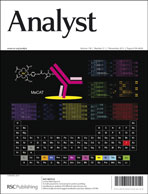A screen-printed endotoxin sensor based on amperometry using a novel p-aminophenol conjugated substrate for a Limulus amebocyte lysate protease reaction†
Abstract
We developed a novel protease detection method based on amperometry using a p-aminophenol (pAP) conjugated substrate. We prepared Boc-Leu-Gly-Arg-pAP (LGR-pAP) as a novel substrate for a clotting enzyme, which is a protease activated by an endotoxin-induced Limulus amebocyte lysate (LAL) cascade reaction. The basic study using cyclic voltammetry revealed that the oxidation peak potentials of LGR-pAP and pAP were sufficiently separated from each other (0.25 V) to conduct amperometric detection of protease activity. We combined simple amperometric detection with a screen-printed electrode chip to produce a practical protease sensor. As an application of the sensor, we demonstrated quantitative endotoxin sensing. The endotoxin activated zymogens contained in the LAL to generate pAP, which was then electrochemically detected by potential step chronoamperometry (PSCA). The observed oxidation current increased with the concentration of endotoxin in the LAL assay solution. This PSCA detection was performed with a disposable chip sensor consisting of a screen-printed electrode and a fluidic channel with a hydrophilic cover. This chip sensor successfully detected 10–1000 EU L−1 endotoxin within 60 min. This novel amperometric measurement with a screen-printed electrode not only provides compact, low-cost, and easy-to-use sensors for on-site monitoring of endotoxin, but also shows promise for use in other in vitro protease assays for biochemical research, diagnosis, and drug development.


 Please wait while we load your content...
Please wait while we load your content...